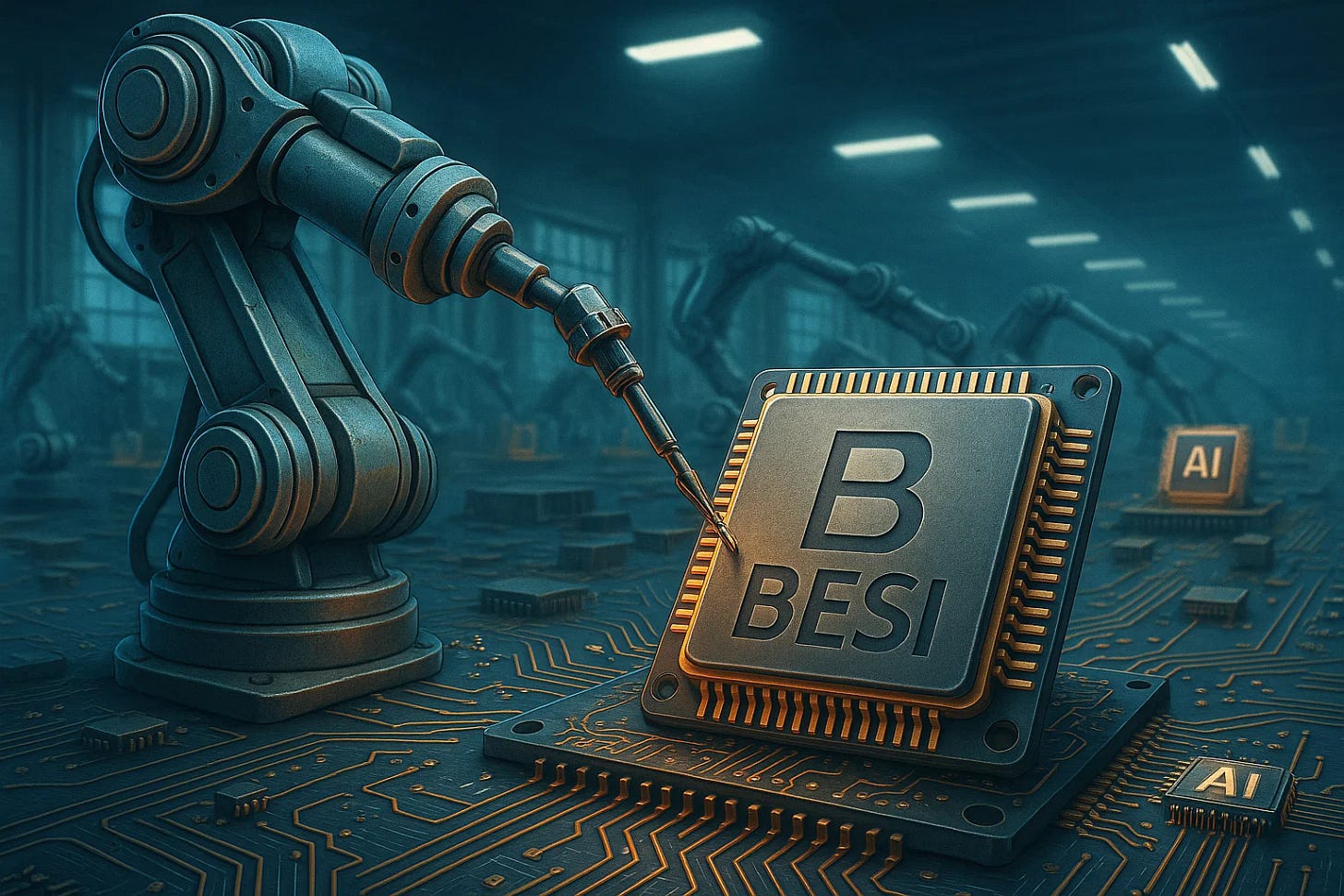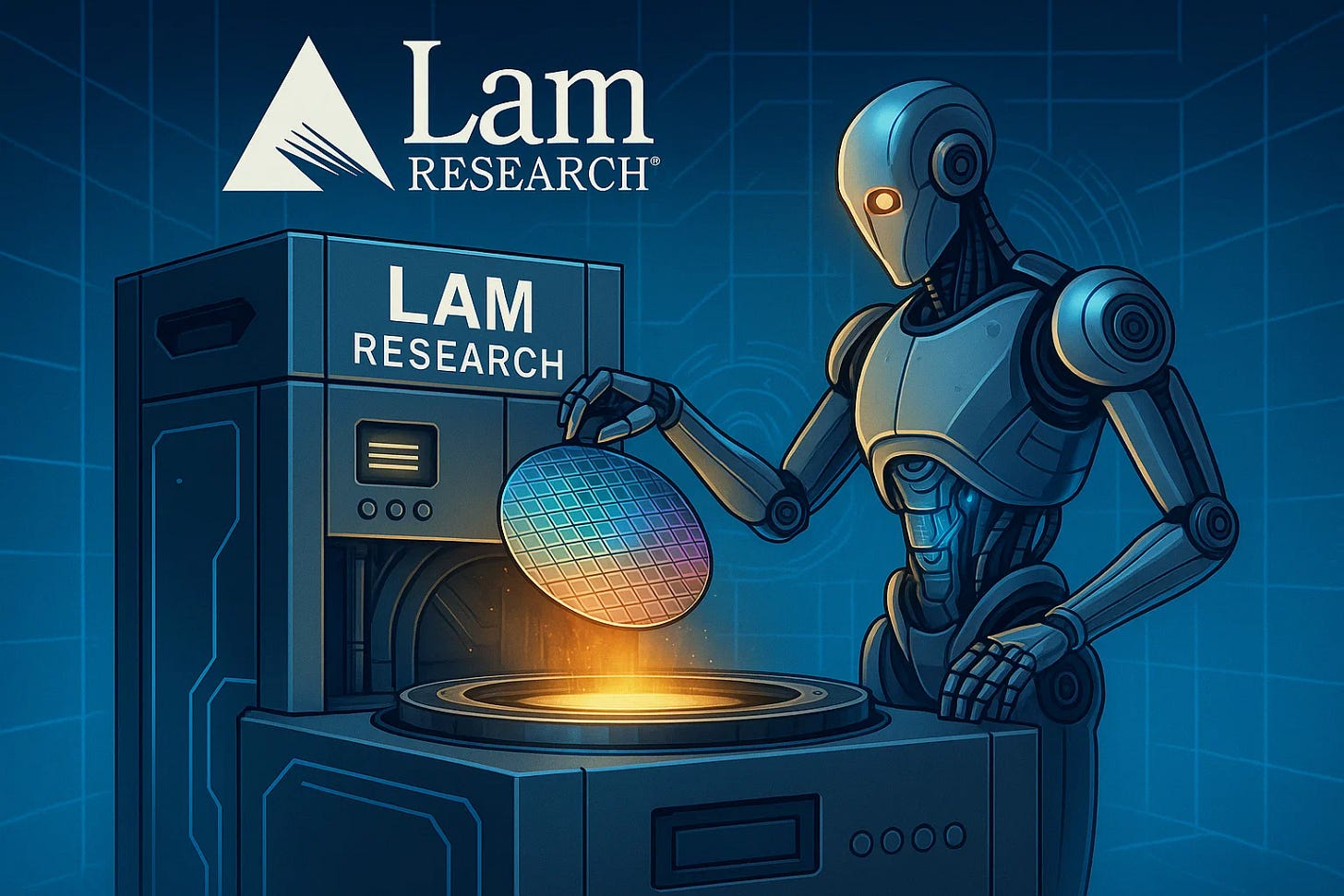Welcome, AI & Semiconductor Investors,
Are investors missing the real winners in the AI hardware race? BESI just unveiled sub-micron bonders set to turbocharge chiplet and HBM stacks, Lam Research is driving gross margins toward 50 % on a $40 billion NAND upgrade wave, and KLA’s 2 nm process-control choke point is becoming the gatekeeper for next-gen wafers, proof that the “shovel makers” of AI packaging may deliver outsized returns beyond the usual GPU names.— Let’s Chip In
What The Chip Happened?
🔩 BESI Tightens the Screws on Advanced Packaging Ambitions
🛠️ Lam Research Turns Up the Margin Dial
🚀 KLA Rides 2‑Nanometer Wave & Advanced Packaging Boom
[Besi Investor Day 2025: Advanced‑Packaging Road Map Scales with AI Boom]
Read time: 7 minutes
Get 15% OFF Finchat — MY FAVORITE STOCK MARKET DATA PLATFORM —
BE Semiconductor Industries N.V. (Euronext Amsterdam: BESI)
🔩 BESI Tightens the Screws on Advanced Packaging Ambitions
What The Chip: On June 12, 2025, BESI used its Analyst & Investor Day to lift the lid on a bolder five‑year plan: revenue ambitions of €1.5 – €1.9 billion (up from €1 billion), gross‑margin goals of ≥66 %, and a sharpened focus on hybrid‑bonding and flux‑less thermocompression tools that feed the AI packaging boom.
The Situation Explained:
🧠 AI at the wheel. Management projects advanced packaging equipment to compound at ~19% through 2030, as GPUs, HBM memory, and co-packaged optics flood data center buildouts.
🚀 Gen‑2 Hybrid Bonder ships in Q4 25. First customer (a “leading Taiwanese foundry”) receives a 50 nm alignment, 3 k UPH test tool this autumn—20 % higher ASP than today’s 100 nm CHAMEO platform.
🔥 TC Next breaks cover. The new fluxless thermocompression bonder promises <0.7 µm placement accuracy and up to 2 k UPH, giving BESI access to HBM‑4/4E and future HBM‑5 stacks. Initial multi‑system order booked this quarter.
🏭 Capacity ready to flex. Malaysian assembly lines can double or triple monthly hybrid‑bonder output within a quarter; Vietnam expansion and an India footprint are next.
💰 Cost discipline endures. A fresh €15 – €30 million cost‑out program—focused on dual‑sourcing and inventory trim—underpins the higher margin target.
💡 Service upsell. As sub-10 µm processes migrate “closer to the fab,” 24/7 process support and spares will become a meaningful gross-profit lever.
📈 Cyclic upside remains. Even “engine 1” mainstream die‑attach is modeled to rebound to ~€1 billion at the next cycle peak, doubling from trough‑level revenue without relying on the new growth engines.
🗣️ Quote‑worthy: CEO Richard Blickman: “Hybrid bonding isn’t a market‑share game—it’s a margin game. Our lead in accuracy and cost of ownership positions us to outperform as AI packaging inflects.”
Why AI/Semiconductor Investors Should Care: BESI is positioning where the puck is headed: sub‑micron die‑placement for chiplets, HBM, and photonic I/O. If hybrid bonding and fluxless TC penetrate as management and customers expect, the company’s richer mix and service pull‑through could sustain mid‑60s gross margins even as volume rebounds. The flip side: any delay in HBM-4/5 or smartphone-chiplet adoption would push revenue to the right, while R&D and cap-ex remain elevated. For investors hunting AI infrastructure plays beyond the usual GPU names, BESI offers leveraged exposure to the “shovel makers” of advanced packaging, with both growth and operational torque.
Get 15% OFF Finchat — MY FAVORITE STOCK MARKET DATA PLATFORM —
Lam Research (NASDAQ: LRCX)
🛠️ Lam Turns Up the Margin Dial
What The Chip: On June 3, 2025, CFO Doug Bettinger told Bank of America’s Tech Conference that Lam’s margin engine is purring again, guiding 49.5 % gross margin for the June quarter even after factoring in new U.S.–China tariffs. The upbeat call spotlighted a NAND‑upgrade cycle, high‑bandwidth‑memory (HBM) demand, and a product lineup CFO Bettinger calls “the most competitive in Lam’s history.”
The Situation Explained:
💰 Margin muscle. Lam last saw $5 billion quarterly revenue in Sep‑22 at 46 % gross margin; the June‑25 guide hits the same top‑line with ~350 bps higher margin thanks to a “close‑to‑customer” manufacturing shift in Asia and richer product mix. “We told you we were going to do this—and we did,” Bettinger said.
📀 $40 billion NAND upgrade super‑cycle. Two‑thirds of global NAND bits sit below 200 layers and can’t support high‑value QLC enterprise SSDs. Lam expects a $40 billion upgrade wave “in the first inning of a nine‑inning game,” grabbing ≈ ⅔ share because its etch & tungsten/moly deposition tools are the bottleneck.
🧠 HBM & DDR5 drive DRAM spend. All three DRAM makers are racing to stack more dies (8→12→16) for HBM4. Lam “owns” the TSV drill‑and‑fill steps and sees DRAM WFE flat YoY but with richer content.
🏗️ WFE outlook steady at ~ $100 billion for 2025 (mid‑single‑digit growth). Strength: leading‑edge foundry/gate‑all‑around and DRAM; Logic modest; NAND rising off a two‑year trough.
🌐 China is still a swing factor. Revenue share slid to 31 % last quarter (≈ 40 % in 2024). Lam bakes tariff costs into guidance and sees no incremental hit from the latest Commerce‑Dept proposals, but concedes visibility is “only as good as customers’ plans.”
🔬 **R&D tops $2 billion. New Akara (deposition) & Halo (etch) platforms position Lam to capture “at least half” of incremental etch/dep dollars as devices go 3‑D and packaging complexity rises.
💸 Cash returns intact. Free‑cash‑flow conversion stayed above 100 % even in 2023’s downturn. Policy: return ≥ 85 % of FCF via a growing dividend (benchmarked to peers) and opportunistic buybacks.
Why AI/Semiconductor Investors Should Care: Lam’s mix shift from memory‑centric weakness to margin‑rich upgrades and HBM volume shows how tool makers can thrive even when headline WFE growth is tepid. A confirmed 49%–plus gross‑margin run‑rate reduces earnings volatility and supports aggressive buybacks. The looming multi‑year NAND retrofit and TSV‑heavy HBM4 ramp give Lam a long demand runway—even if China's spending plateaus. Risks persist (including tariff policy shifts, domestic Chinese tool rivals, and cyclical fluctuations). Still, Lam’s widening margin buffer and sticky CSBG revenue provide downside insulation for investors seeking durable cash flow in the AI hardware stack.
KLA Corporation (NASDAQ: KLAC)
🚀 KLA Rides 2‑Nanometer Wave & Advanced Packaging Boom
What The Chip: On June 3, 2025, CFO Bren Higgins told Bank of America’s Tech Conference that KLA’s demand picture “really hasn’t changed” despite macro noise. Leading‑edge logic at the 2‑nm node, high‑bandwidth‑memory (HBM) DRAM, and booming advanced‑packaging lines keep orders firm while gross‑margin guidance drifts into the mid‑60s%.
The Situation Explained:
🔍 2‑nm intensity spikes. KLA’s share of wafer‑fab equipment (WFE) at 2 nm already tops its 3 nm take‑rate. Gate-all-around transistors, larger HPC dies, and tighter design rules increase process-control spend to roughly 8% of WFE, matching the FinFET inflection point. “Any time you have an architecture change, it tends to be very good for process control,” Higgins said.
📦 Advanced packaging leaps. Management anticipates $850 million in packaging revenue for 2025, up from $500 million last year, as logic-plus-HBM stacks proliferate. The overall advanced‑packaging cap‑ex pool ballooned from $3‑4 billion four years ago to $9‑10 billion today, growing faster than core WFE.
🔧 Service engine hums. Contracted service (≈ 75 % of segment sales) should still post low‑double‑digit growth this year, even with China‑access limits. Lifetime revenue capture per tool now equals ~100 % of original ASP, versus 40‑50 % a decade ago, thanks to systems that “live high‑teens years in fabs.”
🌏 China normalizes. After topping 40% of revenue in CY-24, China is expected to slip to ≈ approximately 30% in 2025. Higgins expects the mix to fall “into the 20 % range” over the next few years as legacy‑node support plateaus.
💲 Margins march higher. FY‑25 gross‑margin guide is 63 %, and tariff headwinds are already baked in. New platforms and richer mix push long‑term model toward “mid-60s,” while incremental operating margin continues to run > 40 %.
⚠️ Watch‑outs. Fab‑access restrictions can choke service revenue quarter‑to‑quarter; advanced‑packaging margins remain a notch below the company average; and any pause in HPC or smartphone/PC refresh cycles could temper 2026 WFE growth.
🏭 Supply muscle. Management insists it can “ramp our supply chain” quickly if inefficiencies (regional subsidies, competitive races) inflate WFE beyond the current mid‑single‑digit outlook.
Why AI/ Semiconductor Investors Should Care: KLA sits at the metrology and inspection choke point that every 2-nm and HBM wafer must clear. With process‑control intensity rising, advanced‑packaging spend compounding, and a service model that prints recurring cash, the firm can outgrow—and out‑margin—the broader WFE market even if China cools or tariffs linger. For investors hunting resilient AI exposure without taking foundry‑cycle risk, KLA’s expanding gross‑margin runway and high‑contract service base make the story hard to ignore.
Youtube Channel - Jose Najarro Stocks
X Account - @_Josenajarro
Get 15% OFF Finchat — MY FAVORITE STOCK MARKET DATA PLATFORM
Disclaimer: This article is intended for educational and informational purposes only and should not be construed as investment advice. Always conduct your own research and consult with a qualified financial advisor before making any investment decisions.
The overview above provides key insights every investor should know, but subscribing to the premium tier unlocks deeper analysis to support your Semiconductor, AI, and Software journey. Behind the paywall, you’ll gain access to in-depth breakdowns of earnings reports, keynotes, and investor conferences across semiconductor, AI, and software companies. With multiple deep dives published weekly, it’s the ultimate resource for staying ahead in the market. Support the newsletter and elevate your investing expertise—subscribe today!
[Paid Subscribers] Besi Investor Day 2025: Advanced‑Packaging Road Map Scales with AI Boom
Date of Event: June 12, 2025 – Capital Markets / Investor Day
Executive Summary
*Reminder: We do not talk about valuations, just an analysis of the earnings/conferences
BE Semiconductor Industries N.V. (Besi) used its 2025 Investor Day to reset the bar for the next five years. Management raised the long‑term revenue ambition from the long‑standing “€1 billion +++” to €1.5 billion–€1.9 billion and lifted the operating‑margin target to 40 %–55 % while keeping the gross‑margin goal at a lofty 64 %–68 %.
Chief Executive Richard Blickman told analysts, “AI expansion drives the continued advanced‑packaging adoption … we already generate 70 % of revenue from advanced packaging, and that proportion is set to rise.” The company’s plan leans on three pillars:
Hybrid Bonding (HB) – extending placement accuracy from 100 nm to 50 nm this year and to 25 nm later in the decade;
Flux‑less Thermocompression Bonding (TC‑Next) – aimed at the 10‑25 µm bump‑pitch gap for high‑bandwidth‑memory (HBM) stacks;
Mainstream Die Attach – refreshed flip‑chip and epoxy bonder lines to serve co‑packaged optics, smartphones, automotive, and power modules.
The new targets follow a solid start to 2025: Q1‑25 revenue €144 million, net income €31.5 million, and orders up 8 % sequentially.
Growth Opportunities
AI‑centric packaging
Besi sees cloud AI driving an 18.9 % compound growth rate for advanced packaging equipment through 2029, with chiplets, HBM, and co‑packaged optics (CPO) multiplying die‑attach steps per device. “Early on, it’s the data‑center build‑out; next, existing products—phones, PCs, cars—become AI‑enabled,” EVP Chris Scanlan explained. Internally, Besi already derives 43 % of revenue from computing customers, an unusually high mix for the company.




